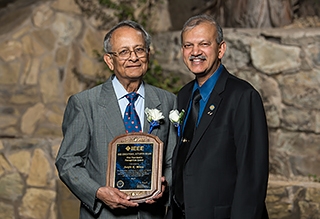Sanjit Mitra, professor emeritus in the Department of Electrical and Computer Engineering, recently received the 2017 IEEE Education Activities Board Vice President’s Award “for outstanding contributions in analog and digital signal processing and image processing, and authoring pioneering textbooks that inspire and educate students worldwide.” He received the award at a formal ceremony in Phoenix, Arizona. In May 2017, two special sessions under the topic “50 Years of Circuits, Systems, & Signals in Honor of Prof. Sanjit K. Mitra” were presented at the 2017 IEEE International Symposium on Circuits & Systems, Baltimore, Maryland.
“We’re immensely proud of Professor Mitra for this award, and we greatly appreciate his decades of service to this university, as both an innovative researcher and a tireless educator dedicated to the needs of students,” said Rod Alferness, dean of the UCSB College of Engineering. “Our emeritus professors are honored and valued members of the CoE community.”
Though officially “retired,” Mitra remains very busy and spends much of his time writing in his office in Harold Frank Hall. He is working on a new undergraduate textbook on analog circuits, and is revising his book Digital Signal Processing: A Computer-Based Approach (McGraw-Hill) for its fifth edition. In 2016 he published Signals & Systems (Oxford) as a first-course text for undergraduates.
Mitra has performed a tremendous amount of fundamental research — working through the mathematics to prove the feasibility of concepts — and his book contains plenty of mathematics, but he also takes a practical approach. “I want to show students the fun part of the profession,” he says, adding, “Most undergraduate texts in electrical and computer engineering make heavy use of mathematics but do not provide practical applications. In my books, I provide simple engineering solutions, in the hope getting students interested in engineering rather than frightening them with lots of mathematics.”
It’s ironic that Mitra should come to be widely recognized for contributions resulting from his mathematics prowess, because his ability was not self-evident when he was growing up in India in the 1940s. “I was probably the last in my class in mathematics; I had no interest,” he says, adding that he had been performing poorly in math for years but received favorable treatment, probably, he guesses, because the teachers wanted to stay in the good graces of his father, an influential lawyer. But when his father got a look at his son’s actual marks in tenth grade, he took away his son’s bike and then spent the summer drilling him in the math needed to get up to speed. Sanjit worked hard and not only got his bike back, but graduated at the top of his class the following year. He then went on to study physics and earn a master’s degree in electronics. He received his PhD in electrical engineering from UC Berkeley in 1962.
As the digital revolution spread around the world, Mitra, who at one point was serving an internship at the Indian Statistical Institute, began to work with India’s first computer, a huge machine with a 1K drum memory that received information and produced results via punch cards. As the first digital computer in Asia, it attracted regional leaders from near and far to see it, even though the machine often gave wrong results due to the relays used to connect the drum for storing and retrieving data.
A number of programs were used for demonstration purposes. One in particular, if supplied with a person’s date of birth, could provide the corresponding day of the week. One time, Mitra recalls, Vietnamese leader Ho Chi Minh came to visit and was asked his date of birth. After the card came out, Ho Chi Minh smiled and walked out of the room. Hand-calculating the date, later, Mitra realized that the computer’s answer had been wrong.
During his studies at UC Berkeley, Mitra spent a summer at Bell Labs and met a number of scientists he “considered gods.” After receiving his PhD, he joined the faculty at Cornell University but left to join Bell labs in New Jersey to escape the severe winter weather in upstate New York. He returned to California as a faculty member at UC Davis in 1967 before transferring to UCSB in 1977.

Professor Emeritus Sanjit Mitra (left) receives the IEEE Education Activities Board Vice President's Award from Vice President, Professor S. K. Ramesh.
